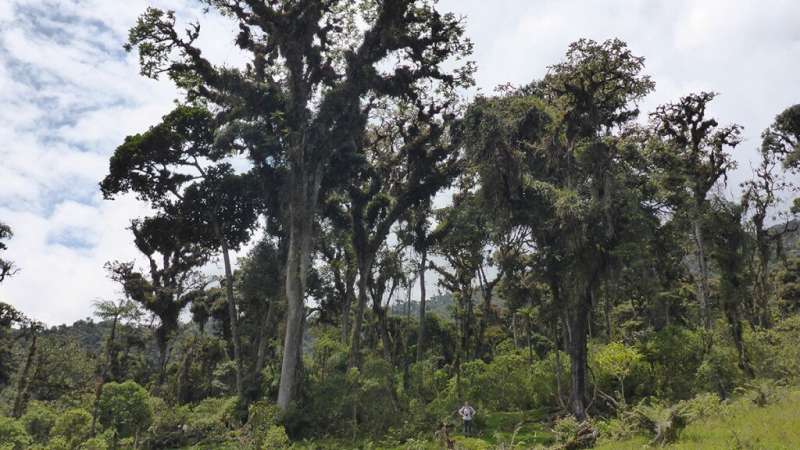To assemble records of past rainfall in the Amazon, scientists collected tree ring samples from multiple sites in Bolivia as well as from this montane forest site near Cuyuja, Ecuador. Credit: Jessica Baker
The Amazon basin contains the world's largest rain forest, famous for its rich biodiversity and importance in the world's oxygen and carbon cycles. It also has an outsized influence on water cycles in South America and beyond. Understanding how climate change is affecting Amazon hydrology is thus a key priority for climate researchers. However, modern measurements of the region's annual rainfall don't provide the historical context needed to explain a recent uptick in wet season precipitation.
In their Journal of Geophysical Research: Biogeosciences study, Baker et al. use more than 200 years of oxygen isotope data from tree rings as a window into the region's hydrological past. Oxygen isotopes can serve as a proxy for historic rainfall amounts because heavier isotopes are more likely to get flushed out of the atmosphere in precipitation in years of greater rainfall. That means rings formed in years with less rainfall should have a higher proportion of heavy oxygen isotopes compared to wetter years.
The data set assembled in this study is the longest oxygen isotope record from the Amazon basin to date and one of the longest such records for any rain forest in the world. To collect it, researchers collected tree ring cores and disks from more than 50 trees growing in lowland rain forest in Bolivia and montane forest in Ecuador. Samples collected from Ecuador provided data from 1799 to 2012, whereas data from Bolivia samples spanned 1860 to 2014.
The records from the two locations matched each other closely, indicating that the trees captured large-scale climate signals not confined only to the regions where the trees were. Oxygen isotope fluctuations from year to year also corresponded well to modern hydrological data, indicating a reliable record of past change.
Because precipitation and sea surface temperatures in the region are linked, the researchers also compared their findings to reconstructed sea surface temperature records. Their data set indicates that annual rainfall in the Amazon decreased as sea surface temperature rose between about 1800 and 1950. After that, the relationship between the two became shakier. In the past couple of decades, the trend reversed, a finding consistent with modern records showing that the Amazon hydrological cycle has amplified in recent years.
More information: Jessica C. A. Baker et al, The Changing Amazon Hydrological Cycle—Inferences From Over 200 Years of Tree‐Ring Oxygen Isotope Data, Journal of Geophysical Research: Biogeosciences (2022). DOI: 10.1029/2022JG006955
Provided by American Geophysical Union
This story is republished courtesy of Eos, hosted by the American Geophysical Union. Read the original story here.
























